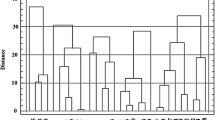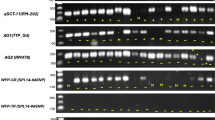Abstract
Phosphorus (P)-deficiency in rice (Oryza. Sativa. L) may cause yield reductions. This research has been conducted to map quantitative trait loci (QTLs) for tolerance to low phosphorus stress in a doubled haploid (DH) population. By using the linkage map of this population, the QTLs for relative dry weight, relative P content and relative P utilization efficiency have been located. The results indicate that one RFLP marker located on chromosome 6 is closely associated with relative root dry weight, relative shoot dry weight and relative total dry weight, which explain 24.9%, 20.5% and 25.2% of the total phenotypic variations, respectively. Two QTLs affect relative P uptake content, which account for 20.7% of the total phenotypic variations. One micro-effect QTL has been found to be associated with relative P utilization efficiency. It is suggested that the P uptake efficiency is more associated with P efficiency. Among the secondary physiological indices of P uptake efficiency, the root dry weight is more important than others.
Similar content being viewed by others
References
Horst, W. J., Abdou, M., Wiesler, F., Genotypic differences in phosphorus efficiency of wheat, Plant and Soil, 1993, 155/156: 293.
Fageria, N. K., Baligar, V. C., Upland rice genotype evaluation for phosphorus use efficiency, Journal of Plant Nutrition, 1997, 20(15): 499.
Alvaro Eleuterio da silva, Warren, H. G., Screening maize inbred lines for tolerance to low-P stress condition, Plant and Soil, 1992, 146:181.
Bochev, B., Genetice basis of mineral nutrition inTriticum aestivum L. II Effect of the cytoplasm on the absorption of nutrient elements, Genetics Aspects of Plant Nutrition, Netherlands: Martinus Nijhoff Publishers, 1983, 429.
Reiter, R. S., Coors, J. G., Sussman, M R. et al., Genetics analysis of tolerance to low-phosphorus stress in maize using RFLP, Theor. Appl. Genet., 1991, 82: 561.
Majumder, N. D., Rakshit, S. C., Borthakur, D. N., Genetic effect on uptake of selected nutrients in some rice, Plant and Soil, 1990, 123: 117.
Li, C. L., Zheng, K. L., RAPD-based analysis for the QTLs related to plant height and heading date, Acta Genetica Sinica (in Chinese), 1998, 25(1): 34.
Zhang, G., Angeles, E. R., Abenes, M. L. P. et al., RAPD and RFLP mapping of the bacterial blight resistance gene Xa-13 in rice, Theor. Appl. Genet., 1996, 93: 65.
Wu, P., Luo, A. C., Ni, J. J. et al., Mapping QTL for potasium deficiency tolerance in rice (Oryza Sativa L.), Plant Nutrition and Fertilizer Science (in Chinese), 1997, 3 (3): 209.
Liu, Y. S., Zhu, L. H., Sun, J. S. et al., Mapping quantitative trait loci for reproductive barriers occurring in hybrid betweenindica andjaponica rice, Acta Botanica Sinica (in Chinese), 1997, 27(5): 421.
Gong, J. M., He, P., Qian, Q. et al., Mapping quantitative trait loci for salt tolerance in rice, Chinese Science Bulletin, 1998, 43(17): 1847.
Mclachlan, K. D., Acid phosphatase: Activity of intact roots and phophorus nutrition in plants. I assay conditions and phosphatase activity, Aust. J. Agric.Res., 1980, 31:429.
Lu, C. F., Shen, L. S., Tan, Z. B. et al., Comparative QTL mapping of agronomic quantitative across environments, Theor. Appl. Genet., 1996, 93:1211.
Zhu, L. H., He, P., Genetic molecular linkage map construction and mapping the important quality and quantitative trait loci in rice (Oryza Sativa L.), Journal of Fudan University (Natural Science) (in Chinese), 1998, 137(4): 509.
Lincoln, S. E., Daly, M. J., Lander, E. S., Mapping Genes Controlling Quantitative Traits Using MAPMAKER/QTL Version 1.1: A Tutorial and Reference Manual, 2nd ed., Cambridge, Mass: Whitehead Institute for Biometrical Research, 1993.
Lander, E. S., Bostein, D., Mapping mondelian factors underlying quantitative traits using RFLP linkage maps, Genetics, 1989, 121: 185.
Ding, H., Li, S. X., Guo, Q. Y. et al., Study on the correlation between acid phosphatase activity and low P tolerance ability in soybean, Plant and Nutrition Science (in Chinese), 1997, 3(2): 123.
He, P., Li, S. G., Li, J. Z. et al., Genetic analysis of genes for rice cooking and appearance quality, Chinese Science Bulletin, 1998, 43(6): 1747.
Noordwijk, van M., Willigen, de P., Ehlert, P. et al., A simple model of P uptake by crops as a possible basis for P fertilizer recommendation, Neth. J. Agric. Sci., 1990, 38: 317.
McMullen, M. D., Byrne, P. F., Snook, M. E. et al., Quantitative trait loci and metabolic pathways, Proc.Natl. Acad. Sci. USA, 1998, 95: 1996.
Author information
Authors and Affiliations
About this article
Cite this article
Ming, F., Zheng, X., Mi, G. et al. Identification of quantitative trait loci affecting tolerance to low phosphorus in rice (Oryza Sativa L.). Chin.Sci.Bull. 45, 520–525 (2000). https://doi.org/10.1007/BF02887097
Received:
Issue Date:
DOI: https://doi.org/10.1007/BF02887097




